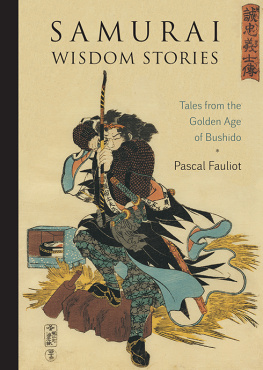APPENDIX A
An Account of the Hara-Kiri ( From a rare Japanese manuscript )
Seppuku ( hara-kiri ) is the mode of suicide adopted amongst Samurai when they have no alternative but to die. Some there are who thus commit suicide of their own free will; others there are who, having committed some crime which does not put them outside the pale of the privileges of the Samurai class, are ordered by their superiors to put an end to their own lives. It is needless to say that it is absolutely necessary that the principal, the witnesses, and the seconds who take part in the affair should be acquainted with all the ceremonies to be observed. A long time ago, a certain Daimio invited a number of persons, versed in the various ceremonies, to call upon him to explain the different forms to be observed by the official witnesses who inspect and verify the head, etc., and then to instruct him in the ceremonies to be observed in the act of suicide; then he showed all these rites to his son and to all his retainers. Another person has said that, as the ceremonies to be gone through by principal, witnesses, and seconds are all very important matters, men should familiarise themselves with a thing which is so terrible, in order that, should the time come for them to take part in it, they may not be taken by surprise.
The witnesses go to see and certify the suicide. For seconds, men are wanted who have distinguished themselves in the military arts. In old days, men used to bear these things in mind; but nowadays the fashion is to be ignorant of such ceremonies, and if upon rare occasions a criminal is handed over to a Daimios charge, that he may perform hara-kiri, it often happens, at the time of execution, that there is no one among all the princes retainers who is competent to act as second, in which case a man has to be engaged in a hurry from some other quarter to cut off the head of the criminal, and for that day he changes his name and becomes a retainer of the prince, either of the middle or lowest class, and the affair is entrusted to him, and so the difficulty is got over: nor is this considered to be a disgrace. It is a great breach of decorum if the second who is a most important officer, commits any mistake (such as not striking off the head at a blow) in the presence of the witnesses sent by the Government. On this account a skilful person must be employed; and, to hide the unmanliness of his own people, a prince must perform the ceremony in this imperfect manner. Every Samurai should be able to cut off a mans head: therefore, to have to employ a stranger to act as second is to incur the charge of ignorance of the arts of war, and is a bitter mortification. However, young men, trusting to their youthful ardour, are apt to be careless, and are certain to make a mistake. Some people there are who, not lacking in skill on ordinary occasions, lose their presence of mind in public, and cannot do themselves justice. It is all the more important, therefore, as the act occurs but rarely, that men who are liable to be called upon to be either principals or seconds or witnesses in the hara-kiri should constantly be examined in their skill as swordsmen, and should be familiar with all the rites, in order that when the time comes they may not lose their presence of mind.
According to one authority, capital punishment may be divided into two kinds beheading and strangulation. The ceremony of hara-kiri was added afterwards in the case of persons belonging to the military class being condemned to death. This was first instituted in the days of the Ashikaga dynasty. At that time the country was in a state of utter confusion; and there were men who, although fighting, were neither guilty of high treason nor of infidelity to their feudal lords, but who by the chances of war were taken prisoners. To drag out such men as these, bound as criminals, and cut their heads off, was intolerably cruel; accordingly, men hit upon a ceremonious mode of suicide by disembowelling, in order to comfort the departed spirit. Even at present, where it becomes necessary to put to death a man who has been guilty of some act unworthy of a Samurai, at the time of the execution witnesses are sent to the house; and the criminal, having bathed and put on new clothes, in obedience to the commands of his superiors, puts an end to himself, but does not on that account forfeit his rank as a Samurai. This is a law for which, in all truth, men should be grateful.
On the preparation of the place of execution
In old days the ceremony of hara-kiri used to be performed in a temple. In the third year of the period called Kan-yei (AD 1626), a certain person, having been guilty of treason, was ordered to disembowel himself, on the fourteenth day of the first month, in the temple of Kichij  ji, at Komagom, in Yedo. Eighteen years later, the retainer of a certain Daimio, having had a dispute with a sailor belonging to an Osaka coasting-ship, killed the sailor; and, an investigation having been made into the matter by the Governor of Osaka, the retainer was ordered to perform hara-kiri, on the twentieth day of the sixth month, in the temple called Sokusanji, in Osaka. During the period Sh
ji, at Komagom, in Yedo. Eighteen years later, the retainer of a certain Daimio, having had a dispute with a sailor belonging to an Osaka coasting-ship, killed the sailor; and, an investigation having been made into the matter by the Governor of Osaka, the retainer was ordered to perform hara-kiri, on the twentieth day of the sixth month, in the temple called Sokusanji, in Osaka. During the period Sh  h
h  (middle of seventeenth century), a certain man, having been guilty of heinous misconduct, performed hara-kiri in the temple called Shimpukuji, in the K
(middle of seventeenth century), a certain man, having been guilty of heinous misconduct, performed hara-kiri in the temple called Shimpukuji, in the K  ji-street of Yedo. On the fourth day of the fifth month of the second year of the period Meirki (AD 1656), a certain man, for having avenged the death of his cousins husband at a place called Shimidzudani, in the K
ji-street of Yedo. On the fourth day of the fifth month of the second year of the period Meirki (AD 1656), a certain man, for having avenged the death of his cousins husband at a place called Shimidzudani, in the K  ji-street, disembowelled himself in the temple called Honseiji. On the twenty-sixth day of the sixth month of the eighth year of the period Yemp
ji-street, disembowelled himself in the temple called Honseiji. On the twenty-sixth day of the sixth month of the eighth year of the period Yemp  (AD 1680), at the funeral ceremonies in honour of the anniversary of the death of Genyuin Sama, a former Shogun, Nait
(AD 1680), at the funeral ceremonies in honour of the anniversary of the death of Genyuin Sama, a former Shogun, Nait  Idzumi no Kami, having a cause of hatred against Nagai Shinano no Kami, killed him at one blow with a short sword, in the main hall of the temple called Z
Idzumi no Kami, having a cause of hatred against Nagai Shinano no Kami, killed him at one blow with a short sword, in the main hall of the temple called Z  j
j  ji (the burial-place of the Shoguns in Yedo). Idzumi no Kami was arrested by the officers present, and on the following day performed hara-kiri at Kirid
ji (the burial-place of the Shoguns in Yedo). Idzumi no Kami was arrested by the officers present, and on the following day performed hara-kiri at Kirid  shi, in the temple called Seiriuji.
shi, in the temple called Seiriuji.
In modern times the ceremony has taken place at night, either in the palace or in the garden of a Daimio, to whom the condemned man has been given in charge. Whether it takes place in the palace or in the garden depends upon the rank of the individual. Daimios and Hatamotos, as a matter of course, and the higher retainers of the Shogun, disembowel themselves in the palace: retainers of lower rank should do so in the garden. In the case of vassals of feudatories, according to the rank of their families, those who, being above the grade of captains, carry the bton, disembowelled himself in the palace of a Daimio called Tamura, as the whole thing was sudden and unexpected, the garden was covered with matting, and on the top of this thick mats were laid and a carpet, and the affair was concluded so; but there are people who say that it was wrong to treat a Daimio thus, as if he had been an ordinary Samurai. But it is said that in old times it was the custom that the ceremony should take place upon a leather carpet spread in the garden; and further, that the proper place is inside a picket fence tied together in the garden: so it is wrong for persons who are only acquainted with one form of the ceremony to accuse Tamura of having acted improperly. If, however, the object was to save the house from the pollution of blood, then the accusation of ill-will may well be brought; for the preparation of the place is of great importance.
















 ji, at Komagom, in Yedo. Eighteen years later, the retainer of a certain Daimio, having had a dispute with a sailor belonging to an Osaka coasting-ship, killed the sailor; and, an investigation having been made into the matter by the Governor of Osaka, the retainer was ordered to perform hara-kiri, on the twentieth day of the sixth month, in the temple called Sokusanji, in Osaka. During the period Sh
ji, at Komagom, in Yedo. Eighteen years later, the retainer of a certain Daimio, having had a dispute with a sailor belonging to an Osaka coasting-ship, killed the sailor; and, an investigation having been made into the matter by the Governor of Osaka, the retainer was ordered to perform hara-kiri, on the twentieth day of the sixth month, in the temple called Sokusanji, in Osaka. During the period Sh